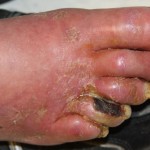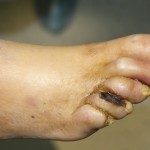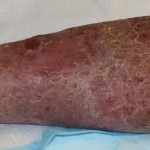I know that sometimes my posts can be a bit esoteric discussing the minutia of antibiotic dosing, findings in the literature, etc. So, to change gears a bit, I would like to make this a rather basic clinical discussion. I know that some of you may find this too simplistic but given the number of residents and students who read this blog I feel it is an important topic.
Since the very first edition of my Handbook of Lower Extremity Infections I have made sure that somewhere within the first page or two of text is a statement along that lines that “Infection is a CLINICAL condition and its diagnosis is made on CLINICAL grounds” (pg 4 of the 3rd edition). You diagnose infection by looking for the classic signs of infection including; erythema, edema, warmth, tenderness, loss of function and purulent drainage. You then take a culture, not to diagnose the infection, but rather to tell you what organism is causing the infection and what antibiotic you need to treat it.
Of course, this definition is all well and good but there are conditions that mimic these signs and symptoms of infection and are frequently misdiagnosed as such when the patient is admitted to the hospital or seen by their physician. The classic one is an acute gout attack. In that situation you have essentially all of the requisite clinical findings including drainage but no infection. I recently was consulted on a patient (unfortunately, I can not find the pictures) who presented with a hot, red swollen first MTP joint admitted with the diagnosis of “cellulitis and osteomyelitis”. All of the clinical findings were there, but what made me suspicious that his foot was not infected, was the drainage. Instead of being your typical creamy, runny or smelly pus you see from foot infections the drainage was pure white and chalky. Furthermore, the x-ray findings looked like the classic Martel’s Sign you see in gouty arthritis with a “rat-bite” appearance. Along with sending off a culture, which came back as no growth, we also sent the drainage to pathology for microscopy. As expected, crystals were found. I was able to discontinue the IV antibiotics.
Another favorite of mine is the patient admitted for “cellulitis” of the foot when, in fact, it is severe dependency rubor from peripheral arterial disease. I saw a patient about 3 weeks ago admitted for gangrene of the 4th toe and cellulitis. Certainly, the toe was gangrenous and there was quite an odor coming from the foot since the patient had not bathed or changed clothes in quite awhile. There was also some slight drainage coming from between the toes but this was not causing the significant erythema the patient exhibited. This patient had the most marked “rubor on dependency, pallor on elevation” (Samuel’s Test) I had ever seen. Usually the color change may take a few minutes but in this patient it was almost immediate. His foot blanched totally. A true infectious cellulitis will not behave this way and residual erythema will still be seen. Cultures only grew diptheroids (which CAN be pathogenic and a topic for a different post). Unfortunately, the patient refused all vascular testing and was discharged back to his bording home.
The third example I want to use is the patient admitted with “cellulitis of bilateral legs”. The most recent patient I saw with this diagnosis was about 250 lbs and sat in a chair almost all day with her legs in a dependent position. She presented with massive edema of both legs, marked erythema bilaterally and multiple serous filled vesicles around the circumference of the her legs. She had been admitted on IV antibiotics. When I saw the patient on consultation it was my opinion that the patient and venous insufficiency and not an infection. True infectious cellulitis does not usually occur as a bilateral and symmetrical condition. When I spoke to the attending I got push-back on that diagnosis since, afterall, the patient “was doing well on IV antibiotics” with reduction in both the erythema and edema. Of course, IMHO the patient was doing well, not because of the IV antibiotics but because she was IN BED with her LEGS ELEVATED!
A key buzzphrase in the infectious diseases community nowadays is “Antibiotic Stewardship”. Although much has been written about it and, at least in California it is now mandated that hospitals develop stewardship programs, the concept is fairly straightforward. Basically, it means that antibiotics should only be used when appropriate and then the right drug should be employed for the diagnosis. The most fundamental idea I would put forward is that sometimes “infections” are not infections and antibiotics are not necessary.
I am sure that all of you reading this can think of other similar situations. PLEASE SHARE your thoughts!




